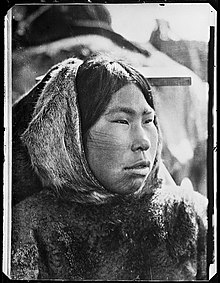


The Netsilik [pronunciation?] (Netsilingmiut[pronunciation?]) are Inuit who live predominantly in Kugaaruk and Gjoa Haven, and somewhat in Taloyoak of the Kitikmeot Region, Nunavut, and, to a smaller extent in the north Qikiqtaaluk Region, in Canada. They were, in the early 20th century, among the last northern indigenous peoples to encounter missionaries from the south.
The missionaries introduced a system of written language called Inuktitut syllabics (Qaniujaaqpait), based on syllabics, to the Netsilik in the 1920s. Eastern Canadian Inuit, among them the Netsilik, were the only Inuit to adopt a syllabic system of writing. The Netsilik's spoken language is Natsilingmiutut. It is a dialect of Inuvialuktun and the only one written in syllabics.[1] The Utkuhiksalingmiut, a Kivallirmiut (Caribou Inuit) group speak a variant of it, Utkuhiksalik.[2]

The harsh Arctic environment that the Netsilik inhabited yielded little plant life, so they had to rely on hunting to acquire most of the resources they needed to survive. In the summer months, the Netsilik would hunt caribou on the tundra. The caribou provided food as well as the hides most commonly used for clothing, although polar bear skins were also used when caribou skin was unavailable. Caribou antlers were also extremely important, and the Netsilik made many implements from caribou antlers, including the breathing hole probe that was integral for seal hunting. In the winter months the Netsilik would migrate out onto the sea ice where they would fish and hunt seal. The Netsilik people used fish as another subsistence strategy when seal and caribou were not available. The Netsilik fished for Arctic char using a kakivaktoimpale fish through a hole in the ice. Any excess fish were stored in ice blocks and saved for a time when fishing and hunting were both unrewarding. Seals also provided the Netsilik with fat for their qulliq (soapstone lamps), which both lit and heated the igloos. This made the Netsilik, and most other Inuit, one of the few peoples to hunt for their heating fuel, rather than use wood.
By 1923, the Netsilik were in possession of firearms, and iron and steel had also begun to replace flint and bone for arrowheads, harpoons, needles, knives and other tools. This made hunting much easier, and the traditional migration patterns of the Netsilik began to change. From the 1930s to the 1960s, Christian missionaries and the Canadian government became more involved in the lives of the Netsilik, who began trading Arctic fox pelts in order to generate income to purchase imported goods. The process of acculturation accelerated in the 1960s, with more and more Netsilik converting to Christianity, moving into permanent settlements built from imported materials, taking up wage labour and using government services. Today, the Netsilik essentially do not practice traditional forms of subsistence, although some elders continue to make traditional artifacts such as kayaks and stone tools and trinkets for museums and for sale.[3]
The Netsilik people were the subject of a 1970s U.S. educational project, Man: A Course of Study, which attracted criticism from American conservative groups.[4]
In 1988 excerpts from Knud Rasmussen's Journals of the Fifth Thule Expedition were used by Canadian / American composer Raymond Luedeke to create an orchestral work with narration, Tales of the Netilik. This work was commissioned by six Canadian orchestras and played throughout Canada. [5]
In the 1920s, Knud Rasmussen, and later in the 1930s, Gontran de Poncins reported that senicide was still practised by the Netsilik of King William's Land.[6]
|
| |||||||||
|---|---|---|---|---|---|---|---|---|---|
| Culture |
| ||||||||
| Material culture |
| ||||||||
| Homelands |
| ||||||||
| Organisations |
| ||||||||
| Notable people |
| ||||||||
| |||||||||
| Authority control databases: National |
|
|---|